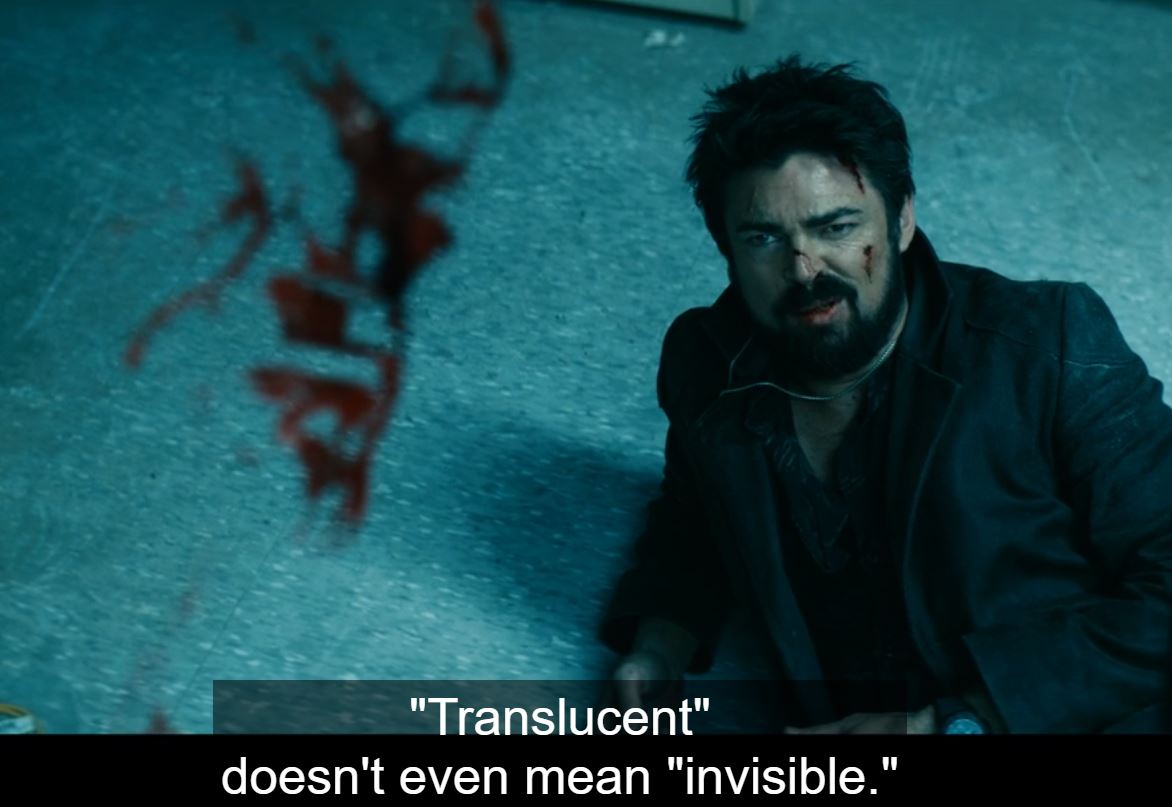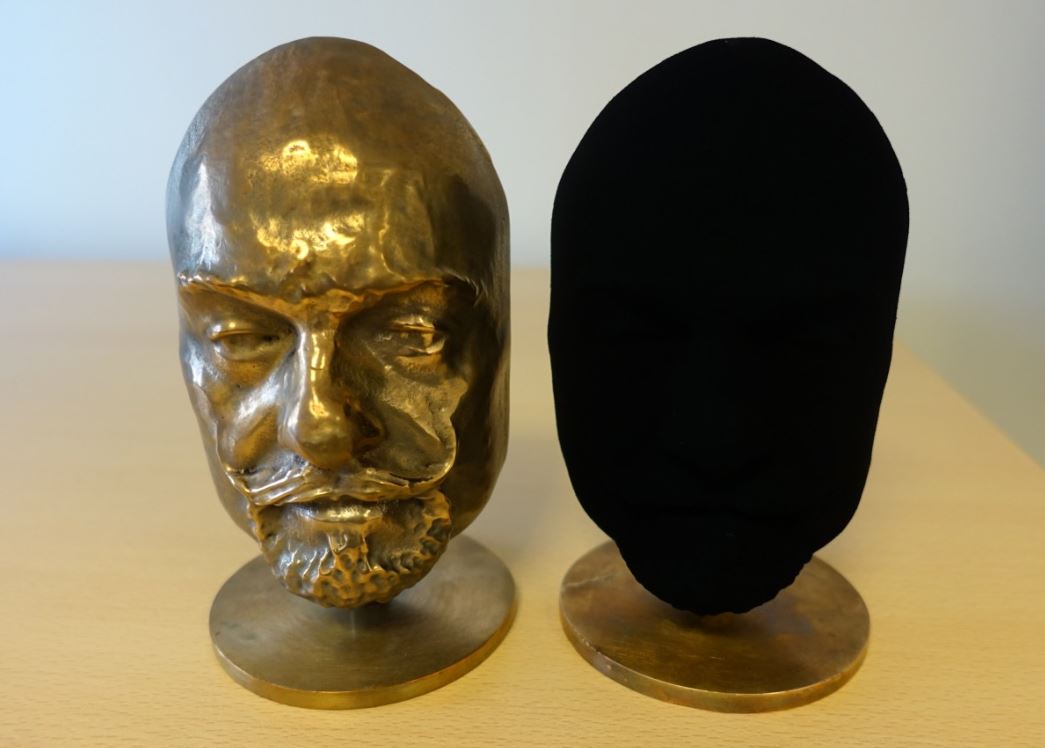I probably need to get this out of the way right off the bat:
If you’re a STEM teacher, you probably don’t want to use the new Amazon Prime series The Boys for any type of lesson.
At all.
Based on the Dynamite comic series by Garth Ennis and Darick Robertson, it’s a very R-rated, and perhaps more realistic take on superheroes, and those who are there to hold them accountable.
Nuff said.
But – there was a nice mention of some cool science in the first episode, and pulling it out might be a neat prompt to get students thinking about how we see, and thus, how we can’t see objects.
The “hero” Translucent, while appearing on (The Boys‘ universe version of) The Tonight Show with Jimmy Fallon, explains that he can turn invisible thanks to his skin turning into a carbon metamaterial that bends the light, like an invisibility cloak. Fallon asks for one more point of clarification after this reveal, that is, Translucent has to be completely naked for his powers to be useful. Otherwise…well, he’s an animated suit of clothes.
Two quick things – the fact that Translucent is naked when he’s in superhero action is used against him later in the episode, and also, this:

Butcher politely correct’s Translucent on his name. (c) Amazon
Yeah, the leader of “the Boys,” Butcher does point out that “translucent” does not, in fact, mean invisible, but rather…if something is translucent, light can pass through the object, but items seen through it are not clearly visible. Think of wax paper or the frosted glass of a shower door.
But back to this “metamaterial.” While it sounds completely like a sci-fi or superhero science thing, metamaterials are real, exist in our world, and someday perhaps, may be able to be used for invisibility, as it is with Translucent.
Metamaterials 101
Literally, metamaterials are “beyond” (“meta” from the Greek) matter, or material. Metamaterials are manufactured to have properties that are not found in nature. They’ve been around since ancient times when artisans and craftsmen would add small amounts of different metals or other ingredients to their work that resulted in unique and often unexpected properties, but the science behind started being fully understood last century, with design and manufacture of specific metamaterials really taking off in this century.
The size of the special ingredients put into ancient glass or other materials was on the nano (billionth of a meter) scale, and that holds true today – metamaterials’ special effects come from specific amounts of incredibly small particles that are combined with other materials. In today’s manufactured metamaterials, the size, shape, density, alignment and other specific properties of the nanoparticles can be controlled in order to produce different effects – including how light behaves when it interacts with an object.
How We See Things – A Refresher
We’re able to see things when light strikes an object and is reflected by the object into our eyes (through the pupil and lens and strikes the retina where the processing starts). The light reflected off of an object can be scattered to varying amounts, affecting the color for instance (which is why some things appear blue when they are actually black). We only see the light that’s reflected off of an object, not the actual object “itself,” is a kind of weird, trippy way to explain it, but it’s true.
But reflection is only one of the ways light can interact with objects. Two other ways light can interact with objects that affect our vision and in the interest of metamaterials are absorption and refraction. The light that is absorbed is just that – the energy from the light is absorbed by the object, and effectively, doesn’t come back out. An object that absorbs all of the light that hits it is black – no light is reflected back out towards the eye of the viewer.
Light can also be refracted, meaning that it slows down as it passes through a new medium (such as water). The light bends due to slowing, and the resultant image can be either hardly noticeable or completely weird.

Refraction in action. His body is actually under his head (as bodies should be) but due to refraction, it’s not.
Virtually any time you see a weird effect of something that’s partly in and partly out of water – that’s refraction. The “amount” that light is refracted in any medium is called that material’s index of refraction, and is easily calculated by the ratio of the velocity of light in a vacuum (3.0 x 108 m/s) and the velocity of light in the new medium (which will be less). The formula looks like this:
n = c/v
Where:
n = the refractive index of the material
c = the velocity of light in a vacuum
v = the velocity of light in the new material
This can also be calculated using the ratio of the angle the light travels inside the new medium to the angle the light travels coming into the new medium, which is called Snell’s Law.
The thing is, look at that first formula – that ratio. Light will always slow down in a new medium, so the refractive index will be larger than one. But – by manipulating materials on the nanoscale, metamaterials with very low, and even negative indices of refraction have been created. But just to be clear, this is through the manipulation of materials, not light traveling faster than the speed of light in the new medium.
And here’s the invisibility thing – match the index of refraction of your materials, and the material will be invisible. Case in point – Wesson cooking oil and Pyrex glass (borosilicate) have approximately the same indices of refraction. As far as the light is concerned in the video below, there’s no difference between the two, thus, the glass of the tube is “invisible.”

Wesson oil being poured into a Pyrex tube, being held in a Pyrex beaker, filled with Wesson.
And of course, match your index of refraction to that of air (which is, by convention, 1.0), and light will act just as if it’s traveling through air. The material will be invisible. No light would be scattered or reflected by the object.
As Andrea Alu points out in his TEDx Talk in Austin in 2013, this was figured out a long time ago and made its way into pop culture via H.G. Wells in The Invisible Man. Griffin – the titular Invisible Man, devised a method to lower the refractive index of materials without changing any of its other properties. As a result of Griffin’s method, the material did not reflect, refract, or absorb light, making it (him) invisible.
Making Stuff Invisible With Metamaterials
To make something invisible with metamaterials, it’s all about that refraction, nothing else. Again – with visible light, if you absorb all the incoming light and eliminate the reflection and scattering of light, the object appears black. Absorb 99+% of incoming light, and you get the effects seen with the Vantablack process.

Identical busts of Shakespeare, but the one on the right is painted with Vantablack and has virtually zero scattered light coming from it. Seriously.
But get the incoming light to refract around the object with no scattering – you’ve got invisibility.
Now, a metamaterial cloak that could do this is one approach, but something even wilder is what Alu and his colleagues suggested in 2005 – design a metamaterial that would scatter/reflect a form of “negative light” that would cancel out the light being scattered by the object. Think of it as something similar to noise-canceling headphones – these headphones create a sound wave that is opposite the incoming sound waves. Taken together, the two waves cancel each other out.
With Alu’s metamaterial, the scattering would be canceled, and the light would go through the object – without a shadow or a distortion. Alu’s group was able to produce the effect they proposed on a three-dimensional object with metamaterials and radio waves rather than light in 2012, but the physics would be the same for light. Radio waves are, like light, electromagnetic waves, but have longer wavelengths than visible light, and thus made their manipulation a little easier. The experiment showed that object (a cylinder) was completely invisible to radio waves – with no shadow (radio waves reflecting off of objects is the basis of RADAR).
The approach has also been successful with microwave radiation as well – which has smaller wavelengths than radio waves. But for visible light?
Yeah, that’s a lot tougher.
Alu and his colleagues – as well as many other researchers working on the problem – have found hard limits to passive cloaking, that is a covering of metamaterial that will render the object beneath it invisible. As wavelengths of incoming light (electromagnetic energy) get smaller, the cloaking becomes much more difficult. Cloaking a relatively small object from radio waves, as Alu showed, is possible thanks in part to the size of the radio waves. Visible light waves are much, much smaller than radio waves, and as a result, making even a small item invisible with this passive method is very difficult, if not impossible.
But that’s passive – there is a possibility (and this works within The Boys episode) that active cloaking, an approach using metamaterials, but required energy, could overcome the size-based hurdle. Likewise, there are other lines of research that may allow for full or a slightly distorted (think the Predator) invisibility – but just not yet.
But this is a region of physics where each little advancement will require a lot – a lot – of work. So basically, while Translucent may be invisible when it comes to visible light, his tech probably wouldn’t be able to make him invisible to ultraviolet, X-rays or gamma rays, all of which have smaller wavelengths than visible light.
Spoilers for the end of the first episode of The Boys ahead…
So if we get back to The Boys, Hughie is able to take Translucent down by electrocuting him – touching him with a live wire. Translucent doesn’t go down well – he’s shown to be getting a full-body shock that finally knocks him down so thoroughly that he and Butcher think he might be dead.
Going by what we just went through, Translucent’s carbon metamaterial coating can’t be passive. Materials and the wavelengths of visible light just won’t allow it now – and that’s probably going to be a hard limit in the future as well. So…Translucent’s “suit” or skin was probably active, meaning it had a power source. Translucent’s response to getting hit with the live wire is pretty consistent with the exaggerated physics of a comic book adaptation, so that could be one way to explain his suit – active cloaking.
Or – you know, it could just be the carbon.
If you think of one of the more common (at least in summertime) forms of carbon that you run into – charcoal, yeah – that’s not jumping out at you as a good conductor of electricity. It’s not. But think of another form (called an allotrope) of carbon – graphite in your pencil (it’s not lead, please stop calling it lead). Graphite and another allotropic version of carbon, graphene, both conduct electricity.
To make matters worse, if your carbon metamaterial is made out of graphene – it conducts electricity with very little resistance, meaning that Translucent was getting all the juice Hughie’s quick thinking with the wire could give him. This conductivity of Carbon is due to the electrons in the outer electron shells of carbon atoms – they can move better in some forms than in others (diamond is not a great conductor).
Graphene by itself doesn’t have the optical properties needed in an invisibility cloak as explained earlier but given a little hand-wavey science here and there, it’s plausible that Translucent’s suit may have a metamaterial infused into a graphene base or understructure.
So what have we learned?
Metamaterials? The real deal, and awesome.
Manipulating light to alter the viewer’s perception? Done all the time.
Metamaterial invisibility? Already here for some types of electromagnetic energy, and probably coming – in some form – for visible light.
Electrically conductive suit? Perhaps not the best idea if you’re fighting someone that’s going to use a naked wire as a weapon.
More:
Alu’s TEDX Talk on metamaterials & invisibility:







